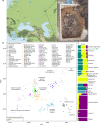Analysis of 3800-year-old Yersinia pestis genomes suggests Bronze Age origin for bubonic plague
- PMID: 29884871
- PMCID: PMC5993720
- DOI: 10.1038/s41467-018-04550-9
Analysis of 3800-year-old Yersinia pestis genomes suggests Bronze Age origin for bubonic plague
Abstract
The origin of Yersinia pestis and the early stages of its evolution are fundamental subjects of investigation given its high virulence and mortality that resulted from past pandemics. Although the earliest evidence of Y. pestis infections in humans has been identified in Late Neolithic/Bronze Age Eurasia (LNBA 5000-3500y BP), these strains lack key genetic components required for flea adaptation, thus making their mode of transmission and disease presentation in humans unclear. Here, we reconstruct ancient Y. pestis genomes from individuals associated with the Late Bronze Age period (~3800 BP) in the Samara region of modern-day Russia. We show clear distinctions between our new strains and the LNBA lineage, and suggest that the full ability for flea-mediated transmission causing bubonic plague evolved more than 1000 years earlier than previously suggested. Finally, we propose that several Y. pestis lineages were established during the Bronze Age, some of which persist to the present day.
Conflict of interest statement
The authors declare no competing interests.
Figures



References
Publication types
MeSH terms
Substances
LinkOut - more resources
Full Text Sources
Other Literature Sources
Medical
Miscellaneous

